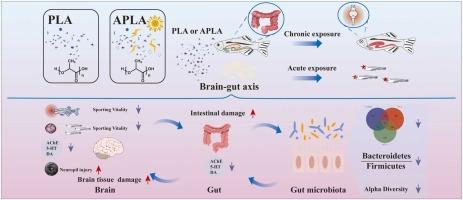Polylactic acid microplastics before and after aging induced neurotoxicity in zebrafish by disrupting the microbiota-gut-brain axis
IF 12.2
1区 环境科学与生态学
Q1 ENGINEERING, ENVIRONMENTAL
引用次数: 0
Abstract
Polylactic acid (PLA) is a biodegradable alternative to traditional plastics due to its excellent biocompatibility. However, PLA is challenging to fully degrade and can easily become microplastics (MPs) in surface water, a process accompanied by aging. This study found that aged PLA (APLA) MPs exhibited increased surface roughness, decreased surface potential, and more oxygen-containing functional groups compared to PLA. Acute exposure to PLA/APLA in zebrafish larvae resulted in sluggish behavior and inhibited neuronal development. Chronic exposure to PLA/APLA in adult zebrafish led to reduced exploratory behavior, poor memory, increased aggression, and neuron loss. Overall, PLA/APLA induced dose-dependent neurotoxicity, with APLA exhibiting greater toxicity than PLA, potentially due to its higher rate of uptake. Additionally, exposure to PLA/APLA led to thinning of the intestinal wall, shortening of villi, and suppression of intestinal neurotransmitter levels, accompanied by alterations in microbial abundance and gut dysbiosis. Meanwhile, supplementation with bile acid, considered as the key regulator in the gut-brain axis, significantly mitigated the neurotoxicity induced by PLA/APLA. These findings confirm that PLA/APLA MPs indeed elicit neurotoxicity via the gut-brain axis and provide scientific evidence for targeted environmental interventions to minimize the adverse ecological impacts of biodegradable MPs.

衰老前后聚乳酸微塑料通过破坏微生物-肠-脑轴诱导斑马鱼神经毒性
聚乳酸(PLA)具有良好的生物相容性,是传统塑料的生物可降解替代品。然而,聚乳酸很难完全降解,在地表水中很容易变成微塑料(MPs),这一过程伴随着老化。该研究发现,与PLA相比,老化的PLA (APLA) MPs表面粗糙度增加,表面电位下降,含氧官能团更多。急性暴露于PLA/APLA的斑马鱼幼虫导致行为迟缓和抑制神经元发育。成年斑马鱼长期暴露于PLA/APLA会导致探索行为减少、记忆力下降、攻击性增加和神经元丧失。总体而言,PLA/APLA诱导剂量依赖性神经毒性,APLA表现出比PLA更大的毒性,可能是由于其更高的摄取速率。此外,暴露于PLA/APLA导致肠壁变薄,绒毛缩短,肠道神经递质水平抑制,并伴有微生物丰度改变和肠道生态失调。同时,添加胆汁酸可以显著减轻PLA/APLA引起的神经毒性,胆汁酸被认为是肠脑轴的关键调节因子。这些发现证实了PLA/APLA MPs确实通过肠-脑轴引起神经毒性,并为有针对性的环境干预提供了科学证据,以尽量减少可生物降解MPs的不利生态影响。
本文章由计算机程序翻译,如有差异,请以英文原文为准。
求助全文
约1分钟内获得全文
求助全文
来源期刊

Journal of Hazardous Materials
工程技术-工程:环境
CiteScore
25.40
自引率
5.90%
发文量
3059
审稿时长
58 days
期刊介绍:
The Journal of Hazardous Materials serves as a global platform for promoting cutting-edge research in the field of Environmental Science and Engineering. Our publication features a wide range of articles, including full-length research papers, review articles, and perspectives, with the aim of enhancing our understanding of the dangers and risks associated with various materials concerning public health and the environment. It is important to note that the term "environmental contaminants" refers specifically to substances that pose hazardous effects through contamination, while excluding those that do not have such impacts on the environment or human health. Moreover, we emphasize the distinction between wastes and hazardous materials in order to provide further clarity on the scope of the journal. We have a keen interest in exploring specific compounds and microbial agents that have adverse effects on the environment.
 求助内容:
求助内容: 应助结果提醒方式:
应助结果提醒方式:


